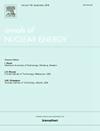流动LBE中多机制耦合腐蚀颗粒沉积模型
IF 1.9
3区 工程技术
Q1 NUCLEAR SCIENCE & TECHNOLOGY
引用次数: 0
摘要
在铅冷快堆中,腐蚀产物在管壁上的积累会导致热工性能和流动性能下降。本文的目的是利用欧拉沉积模型预测铅铋共晶中腐蚀产物的沉积速率。该模型考虑了布朗扩散、湍流扩散、热电泳沉积和对流加速沉积、湍流电泳和稳态粘滞阻力。该模型还考虑了作用在高密度LBE粒子上的虚质量力和浮力。基于修正后的模型,分析了腐蚀颗粒沉积的机理,详细考察了各种因素对沉积速率的影响。结果表明,扩散是小颗粒沉积的主要机制。壁面粗糙度和热泳动对壁面小颗粒的沉积速率均有显著影响。浮力和LBE流速对颗粒沉积速率也有显著影响。本文章由计算机程序翻译,如有差异,请以英文原文为准。
Deposition model of corrosion particles with multi-mechanism coupling in flowing LBE
The accumulation of corrosion products on pipe walls can degrade thermal and flow performance in lead-cooled fast reactor. The objective of this paper is to predict the deposition rates of corrosion products in lead–bismuth eutectic (LBE) using Eulerian deposition model. The model takes into account Brownian diffusion, turbulent diffusion, thermophoresis deposition and convective deposition with acceleration, turbophoresis and steady-state viscous drag. The model also considers the virtual mass force and buoyancy acting on the particles in the high density LBE. Based on the modified model, this paper analyses the mechanism of corrosion particles deposition and investigates the effects of various factors on the deposition rate in detail. Results indicate that diffusion is the primary deposition mechanism of small particles. Both wall roughness and thermophoresis significantly influence particle deposition rate of small particles on the wall. Buoyancy and LBE flow rate also have a significant impact on the particle deposition rate.
求助全文
通过发布文献求助,成功后即可免费获取论文全文。
去求助
来源期刊

Annals of Nuclear Energy
工程技术-核科学技术
CiteScore
4.30
自引率
21.10%
发文量
632
审稿时长
7.3 months
期刊介绍:
Annals of Nuclear Energy provides an international medium for the communication of original research, ideas and developments in all areas of the field of nuclear energy science and technology. Its scope embraces nuclear fuel reserves, fuel cycles and cost, materials, processing, system and component technology (fission only), design and optimization, direct conversion of nuclear energy sources, environmental control, reactor physics, heat transfer and fluid dynamics, structural analysis, fuel management, future developments, nuclear fuel and safety, nuclear aerosol, neutron physics, computer technology (both software and hardware), risk assessment, radioactive waste disposal and reactor thermal hydraulics. Papers submitted to Annals need to demonstrate a clear link to nuclear power generation/nuclear engineering. Papers which deal with pure nuclear physics, pure health physics, imaging, or attenuation and shielding properties of concretes and various geological materials are not within the scope of the journal. Also, papers that deal with policy or economics are not within the scope of the journal.
 求助内容:
求助内容: 应助结果提醒方式:
应助结果提醒方式:


